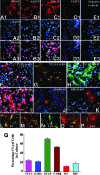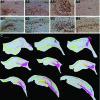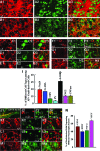Neural stem cell grafting counteracts hippocampal injury-mediated impairments in mood, memory, and neurogenesis
- PMID: 23197876
- PMCID: PMC3612501
- DOI: 10.5966/sctm.2012-0050
Neural stem cell grafting counteracts hippocampal injury-mediated impairments in mood, memory, and neurogenesis
Abstract
The hippocampus is vital for functions such as mood and memory. Hippocampal injury typically leads to mood and memory impairments associated with reduced and aberrant neurogenesis in the dentate gyrus. We examined whether neural stem cell (NSC) grafting after hippocampal injury would counteract impairments in mood, memory, and neurogenesis. We expanded NSCs from the anterior subventricular zone (SVZ) of postnatal F344 rat pups expressing the human placental alkaline phosphatase and grafted them into the hippocampus of young adult F344 rats at 5 days after an injury inflicted through a unilateral intracerebroventricular administration of kainic acid. Analyses through forced swim, water maze, and novel object recognition tests revealed significant impairments in mood and memory function in animals that underwent injury and sham-grafting surgery. In contrast, animals that received SVZ-NSC grafts after injury exhibited mood and memory function comparable to those of naïve control animals. Graft-derived cells exhibited excellent survival and pervasive migration, and they differentiated into neurons, subtypes of inhibitory GABAergic interneurons, astrocytes, oligodendrocytes, and oligodendrocyte progenitors. Significant fractions of graft-derived cells also expressed beneficial neurotrophic factors such as the glial cell line-derived neurotrophic factor, brain-derived neurotrophic factor, fibroblast growth factor, and vascular endothelial growth factor. Furthermore, SVZ-NSC grafting counteracted the injury-induced reductions and abnormalities in neurogenesis by both maintaining a normal level of NSC activity in the subgranular zone and providing protection to reelin+ interneurons in the dentate gyrus. These results underscore that early SVZ-NSC grafting intervention after hippocampal injury is efficacious for thwarting mood and memory dysfunction and abnormal neurogenesis.
Figures






Similar articles
-
Grafted Subventricular Zone Neural Stem Cells Display Robust Engraftment and Similar Differentiation Properties and Form New Neurogenic Niches in the Young and Aged Hippocampus.Stem Cells Transl Med. 2016 Sep;5(9):1204-15. doi: 10.5966/sctm.2015-0270. Epub 2016 May 18. Stem Cells Transl Med. 2016. PMID: 27194744 Free PMC article.
-
Hippocampal injury-induced cognitive and mood dysfunction, altered neurogenesis, and epilepsy: can early neural stem cell grafting intervention provide protection?Epilepsy Behav. 2014 Sep;38:117-24. doi: 10.1016/j.yebeh.2013.12.001. Epub 2014 Jan 13. Epilepsy Behav. 2014. PMID: 24433836 Free PMC article. Review.
-
Hippocampal Neural Stem Cell Grafting after Status Epilepticus Alleviates Chronic Epilepsy and Abnormal Plasticity, and Maintains Better Memory and Mood Function.Aging Dis. 2020 Dec 1;11(6):1374-1394. doi: 10.14336/AD.2020.1020. eCollection 2020 Dec. Aging Dis. 2020. PMID: 33269095 Free PMC article.
-
Increased dentate neurogenesis after grafting of glial restricted progenitors or neural stem cells in the aging hippocampus.Stem Cells. 2007 Aug;25(8):2104-17. doi: 10.1634/stemcells.2006-0726. Epub 2007 May 17. Stem Cells. 2007. PMID: 17510219
-
Adult neurogenesis in the mammalian dentate gyrus.Anat Histol Embryol. 2020 Jan;49(1):3-16. doi: 10.1111/ahe.12496. Epub 2019 Sep 30. Anat Histol Embryol. 2020. PMID: 31568602 Review.
Cited by
-
Extracellular vesicles from human iPSC-derived neural stem cells: miRNA and protein signatures, and anti-inflammatory and neurogenic properties.J Extracell Vesicles. 2020 Aug 26;9(1):1809064. doi: 10.1080/20013078.2020.1809064. J Extracell Vesicles. 2020. PMID: 32944193 Free PMC article.
-
Object location and object recognition memory impairments, motivation deficits and depression in a model of Gulf War illness.Front Behav Neurosci. 2014 Mar 13;8:78. doi: 10.3389/fnbeh.2014.00078. eCollection 2014. Front Behav Neurosci. 2014. PMID: 24659961 Free PMC article.
-
Curcumin treatment leads to better cognitive and mood function in a model of Gulf War Illness with enhanced neurogenesis, and alleviation of inflammation and mitochondrial dysfunction in the hippocampus.Brain Behav Immun. 2018 Mar;69:499-514. doi: 10.1016/j.bbi.2018.01.009. Epub 2018 Feb 15. Brain Behav Immun. 2018. PMID: 29454881 Free PMC article.
-
Extracellular Vesicles in the Forebrain Display Reduced miR-346 and miR-331-3p in a Rat Model of Chronic Temporal Lobe Epilepsy.Mol Neurobiol. 2020 Mar;57(3):1674-1687. doi: 10.1007/s12035-019-01797-1. Epub 2019 Dec 7. Mol Neurobiol. 2020. PMID: 31813125 Free PMC article.
-
Resveratrol prevents age-related memory and mood dysfunction with increased hippocampal neurogenesis and microvasculature, and reduced glial activation.Sci Rep. 2015 Jan 28;5:8075. doi: 10.1038/srep08075. Sci Rep. 2015. PMID: 25627672 Free PMC article.
References
-
- Kryukov VI. The role of the hippocampus in long-term memory: Is it memory store or comparator? J Integr Neurosci. 2008;7:117–184. - PubMed
-
- Samuels BA, Hen R. Neurogenesis and affective disorders. Eur J Neurosci. 2011;33:1152–1159. - PubMed
-
- Cohen AS, Pfister BJ, Schwarzbach E, et al. Injury-induced alterations in CNS electrophysiology. Prog Brain Res. 2007;161:143–169. - PubMed
Publication types
MeSH terms
Substances
Grants and funding
LinkOut - more resources
Full Text Sources
Medical

